What’s the secret of stunning garden pots?
Expensive containers? Choosing the right plants? Having an artistic eye for arrangement?
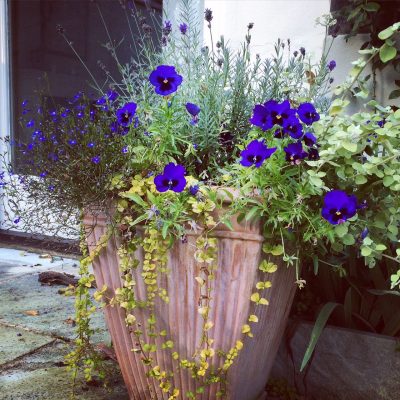
This beautifully planted pot follows the ‘Thriller, Filler, Spiller’ container planting technique. The thriller is purple pansies, the filler is French lavender and the spiller is a trailing ivy.
Maybe. But we’ve all seen wonderful displays of common plants in quite ordinary pots, so it’s certainly not the full story.
After experiencing many disappointments in my own pots, I have quizzed experts to come up with these tips:
-
Feed and water your plants
This advice usually comes at the end of any advice on creating wonderful container planting displays. So it went into the ‘small print’ section of my brain. ‘At the end’ equates to ‘not important’.
That’s why I’m putting it at the beginning of this post. I think it’s probably the biggest single difference between a ho-hum collection of planted pots and a stunning display of container plants. Feel free to disagree with me.
This is a collaborative post with Baby Bio Outdoor liquid feed (note to Bayer, link to microsite here). I have drawn on their expertise, as well as my own and other people’s experience.
What you need to know about watering:
Potted plants don’t pick up rain water properly.
That’s because as plants grow and develop in pots, their growth spreads, explain the Baby Bio Outdoor experts. That usually prevents rain water from falling in any significant proportion to be useful to the plant.
So pots need regular watering, especially during the main growing season. About twice a week on average.
Bear in mind that larger pots will probably require less water as they will not dry out as quickly as smaller ones. Very small pots may need almost daily watering.
Fill the pot up to the rim so that all the soil is covered, say the Royal Horticultural Society (RHS). Let it drain through completely, then repeat.
What you need to know about feeding
Plants in pots can only take up nutrients available to them in the soil that’s actually in the pot.
Without the addition of plant food provided with weekly or fortnightly treatments, these nutrients will run out within weeks.
Use either a liquid fertiliser – such as Baby Bio Outdoor – every two weeks, or a slow-release granular fertiliser like Toprose at the start of the season to make sure that your plants have the nutrients they need to maintain healthy growth

There’s a growing (excuse my pun) interest in vegetables in pots – and veg really are hungry plants. Feed them with a specialist fruit & vegetable feed such as Baby Bio Outdoor Fruit & Vegetables.
But don’t overfeed – mark feeding days in your diary, especially if you’re feeding lots of different plants at different times.
With a soluble plant food, ensure you follow instructions in relation to the amount of plant food and volumes of water required
Take care that the pot is thoroughly and regularly fed and watered. Regular feeding is required throughout the main growing season whatever the pot size, to benefit all plants.
Ericaceous plants such as rhododendrons, camellias and azaleas require an ericaceous plant food to provide them with all their required nutrients.
2) Don’t use garden soil in pots
Garden soil in a pot probably won’t have the right balance of nutrients and it will have weed seeds. If your pots are to have a fighting chance, they need commercial multi-purpose potting compost.
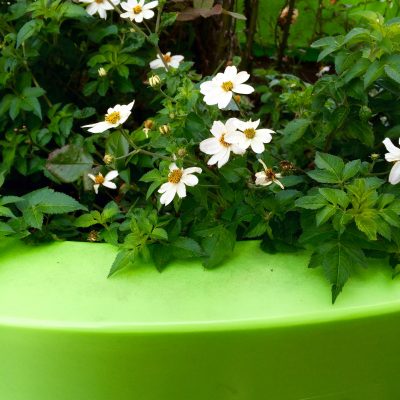
Don’t forget that coloured pots can be very effective. I spotted this lovely combination of bright green pots and simple daisy planting in a street in Calais.
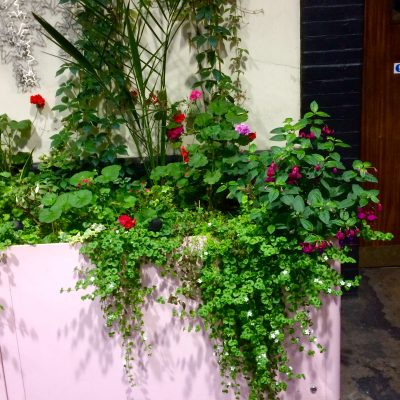
And this very effective pale pink planter with red and pink flowers, plus lots of green, at Edgware Road tube station in London!
3) Change the compost when you change the planting
When I wrote this in my previous post on 25 inspirational ideas for pots, there were howls of anguish from people who have very large planters and pots.
It really isn’t affordable to re-fill large planting pots with five or six bags of commercial multi-purpose potting compost every time you change a display. And if the plants’ roots are fairly shallow, they probably aren’t going down to the bottom of the pot anyway.

If you change the lupins in these large planting pots from Capital Garden products, you wouldn’t need to change ALL the soil in the larger pots. Using the same plants in different pots is a good style tip – if there’s a plant going cheaply, you can buy a trayful.
Most experts agree that – in large plant containers – it’s fine to scrape away the layer the plants sat in and replenish it.
However if the container plants stop thriving, the compost that’s been sitting in the pot may have picked up viruses or pests so you should change the lot.
The RHS also say that, for large planting pots, you can use a mix of two-thirds garden soil to multi-purpose potting compost, provided you add a general-purpose fertiliser.
Baby Bio® Outdoor or Phostrogen® Patio Plant Food would both be ideal. Baby Bio® Outdoor is a liquid plant food so just add 10ml of the rich liquid to 1 litre of water and apply to the compost once you’ve firmed in your new plants. Phostrogen® Patio Plant Food is soluble.
Mix in a watering can according to the instructions on the pack and water it onto the compost, or simply mix a handful with the compost before planting.
In smaller planting pots, it’s better to bite the bullet and buy new compost every time.
4) ) Evergreen plants are great for garden pots
I love evergreens, such as bay, box or pine, in pots. They give structure to the garden all year round.
And it’s great to have some pots that don’t need renewing – because changing all your pots once or twice a year can get expensive.
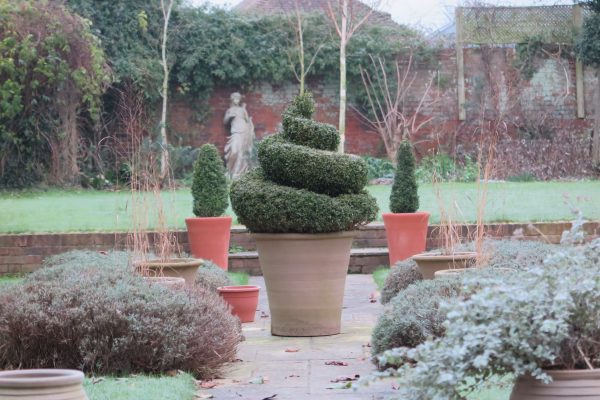
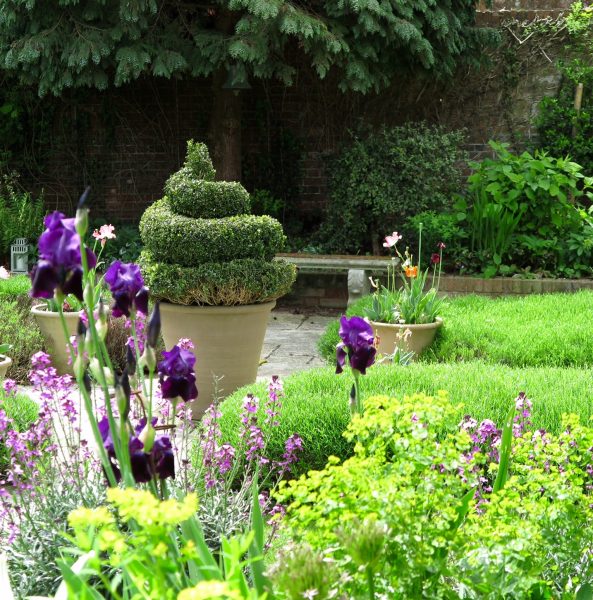
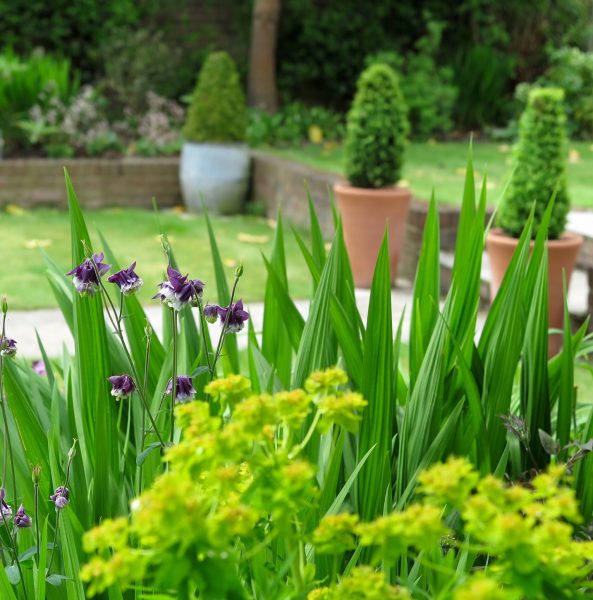
But evergreens in pots do need different care from annual pots. Bellamont Topiary sell yew and box from their fields. They advise you to take evergreens out of their pots every two years, change the potting compost completely and do a hard ‘root trim’. Then replace the plant in the pot (or pot it in a larger one if that’s what you want).
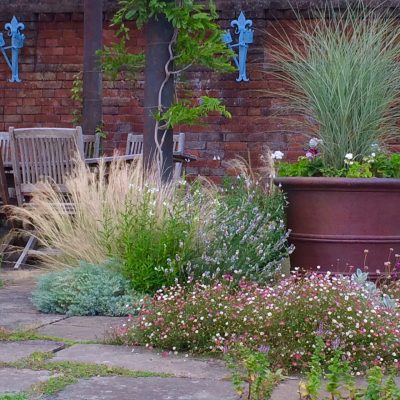
Grasses, like evergreens, can provide planting that lasts for a couple of years in pots: giant coppers at Doddington Place Gardens are planted with grasses. Grasses make a simple, effective planting. Extra plants are added seasonally around the outside.
If you have a permanent plant (such as an evergreen or a grass) in a pot that doesn’t seem happy, check your feeding and watering routines. Evergreens in pots need a slow-release fertiliser during the summer (April to August).
The most important plant in my garden is a topiary box spiral in a large planting pot. I bought it from a topiary field in Dorset last September (for the full story on buying sensational topiary on a middle-sized budget, see here.)
In my last post about using fertiliser (see here), I noted that my topiary spiral had no new growth, while the other box in pots were sprinkled with bright new leaves.
I added a pick-me-up of liquid Baby Bio Outdoor (Flowers & Shrubs). And it worked – now, three weeks later, there are lots of new pale green shoots emerging. I’m also doing the Baby Bio Boost challenge over the summer, where I treat some plants with Baby Bio and others are just watered. Check out the results on the Baby Bio Facebook page (here).
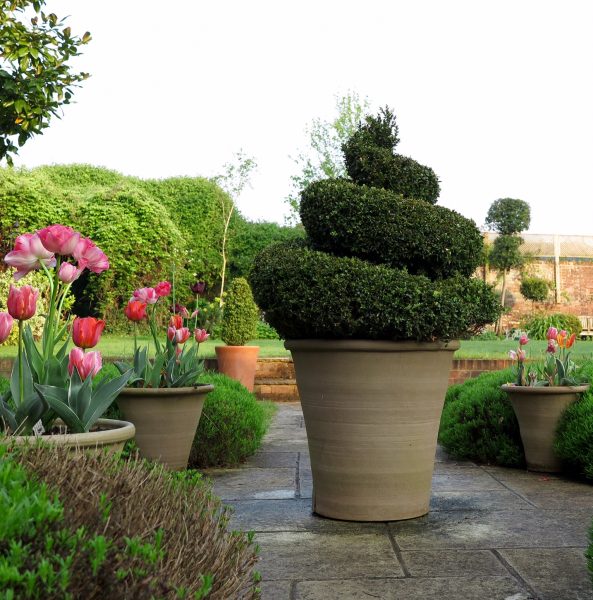

5) Choose the right size pot
Choose a pot that is a bit larger than the roots of the plant you want to put in it. A small plant in too large a pot may rot because its roots aren’t big enough to dry the compost out enough. It’s called ‘over-potting’. I feel the term should be used more widely – possibly with reference to celebrities or politicians who find themselves going to rot in over-large pots…
Too small a pot will stop the plant flourishing.
Big pots retain water better than small planting pots. If you have lots of small pots, group them together. They will protect each other (a bit) from sun and wind, so won’t dry out as quickly.
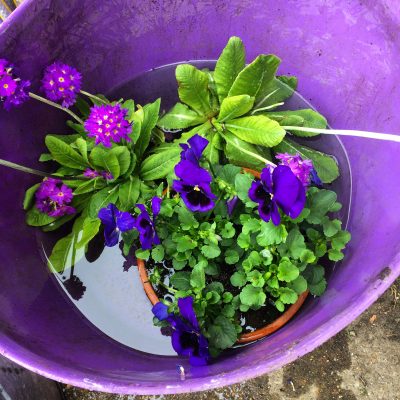
I usually soak small planting pots in a bucket or sink overnight once or twice a week if the weather is hot.
Re-pot in spring. Or even summer. But not in the autumn (unless you’re doing ‘winter interest’ pots, in which case make sure they don’t get water-logged in the bad weather).
There’s still a debate as to whether pots need crocks at the bottom of them to improve drainage. The RHS say you need crocks. ‘Which’ magazine say that their tests show it makes no difference.
6) Any plant can be put in a pot
If you have leftover seedlings or plants that don’t have a place at the moment, then make them part of your container garden display. One of my most successful pots last year was an Echinacea ‘Southern Belle’.
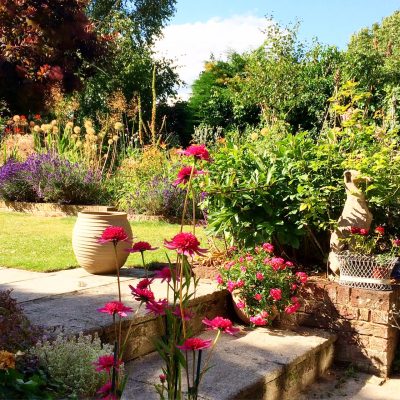
Echinacea ‘Southern Belle’ is the pink flower in the foreground. (It’s in a pot, but that’s out of the picture).
I’d bought too many plants for the border. The ones I put in pots were even more successful than the ones I planted out.
This year I am inspired by Ian Hodgson’s new book New Wild Garden to create a ‘meadow’ in a container. It has a number of ideas for incorporating wildlife-friendly planting into all areas of your garden, including pots.
I long for a little patch of meadow – but I don’t think it would fit into the garden. But I have an old galvanished trough, so I’ll try that out as a mini-meadow.
Giveaway:
There are three sets of Baby Bio Outdoor liquid feed (one bottle of Fruit & Vegetable and one of Flowers & Shrubs) to be won. Just leave a comment below saying what your main container planting problem is – or tweet it to me @midsizegarden. Winners will be picked at random on 12th June.
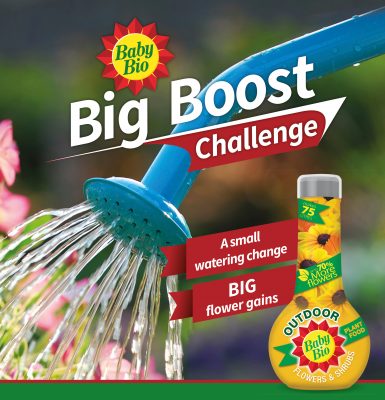
Three sets of Baby Bio Outdoor (Flowers & Shrubs + Fruit & Vegetables) to be given away.
The post Your best garden pots ever – 6 tips for brilliant container gardening appeared first on The Middle-Sized Garden.
from The Middle-Sized Garden http://www.themiddlesizedgarden.co.uk/best-pots-ever-6-tips-brilliant-container-gardening/
No comments:
Post a Comment